► New Mustang meets the Ford icons
► 60 years of the Mustang with new Dark Horse
► Everything from Fiesta to GT40 in one place
Imagine Ferrari making a supermini, or Vauxhall a supercar – it’d be madness. Yet Ford’s aced both niches, not to mention made household names of everything in between.
The 60th anniversary of the Mustang is the perfect chance to dig into that legacy, plus assess how the latest UK-bound Mustang stacks up against both the original and a cast of Blue Oval greats from this side of the pond.
Championed by Lee Iacocca, the Mustang kickstarted the pony-car boom, shifting 418,000 units in its first year alone. The car we’re driving is an early example – identified as a Fastback by its sleeker rear end – and as a pre-’66 by giveaways including gills either side of the front grille and a horizontally ‘swept’ instrument cluster, not the later cars’ recessed round dials.
Its entry-level 4.7-litre V8 is fed by a two-barrel carb and makes just 200 horsepower. But this car sounds and feels fantastic – a big rowdy flourish on start-up, the V8 surges forward on a breath of throttle, like I’m barely scraping the surface and there’s so much more to come. Good job when the rare three-speed manual has chasms between its ratios.
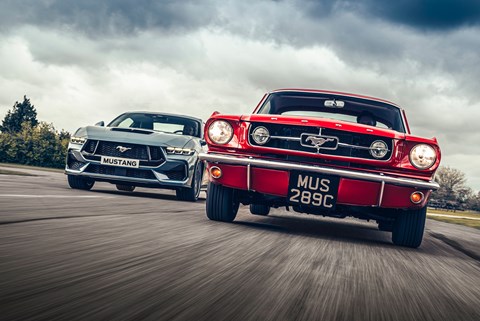
Best experienced with one hand on the tiller and an elbow in the breeze, the Mustang’s thin-rimmed steering wheel twirls lazily, its suspension rolls with a doughy squidge and the unloaded inside rear wheel spins if you accelerate early in a corner. But it’s a fantastically evocative drive, conjuring wide-open freeways, sun-drenched summers and rowdy runs from the lights. I’d love one.
The new Mustang sticks to that template so faithfully that only a Porsche 911 – that other ’60s icon – can match it for consistency and staying true to the original design and mechanical layout. Sixty years on, the long bonnet/short tail proportions could be nothing else, the V8 is only 300cc larger at 5.0 litres, and drive still goes to the rear via a manual or auto transmission.
Power comes in the form of a Coyote V8 with direct injection, variable valve timing and, at 440bhp, more than twice the power, while those trademark dash dials make way for twin screens with 3D graphics that – thanks to a recent over-the-air update – can evoke the originals.
I loved driving the charismatic Dark Horse in California late last year. That car costs £68k in the UK and gets a shade more power, a unique chassis tune and a few more treats, where this is the entry-level £55,725 GT, complete with standard (for UK buyers) Performance pack that bundles in 19-inch alloys, Brembos brakes, an active exhaust and limited-slip differential.

Ford says the Mustang is the world’s biggest-selling sports car of the last decade, and official UK imports from 2015 have played a part in that. Five decades earlier, Ford sent 27-year-old Alan Mann one of the very first early pre-production Mustangs to assess at Goodwood, before his eponymous team won the Tour de France in 1964 – the Mustang’s first ever victory – then the following year’s British Saloon Car Championship.
With Ford’s Total Performance motorsport strategy in full swing, Mann had impressed the top brass a year or so earlier, when a Lotus Cortina he ran for a UK dealer beat Ford Falcons on home turf at the 1963 Marlboro 12-hour race (the Mustang shared Falcon bits).
In fact, the Ford Cortina Lotus – as it’s officially known – won many things, including the 1964 British Saloon Car Championship with Lotus F1 driver Jim Clark. A gorgeously simple three-box design dropped over a narrow track and undernourished wheels, the Lotus-tweaked Cortina features a 1558cc four with a twin-cam head, twin-choke Weber carbs and Cosworth pistons good for 105bhp and 108lb ft, plus uprated suspension, a close-ratio gearbox and aluminium doors, body and bonnet. Ford and Lotus sold 3301 in three years.

You sit low in this chassis, beneath inches of headroom, each corner of the car easily visible through generous glazing, thin pillars and a complete absence of head restraints. The trim is mostly black, instruments are set in a metal facia while a wooden steering wheel and gearknob – both slender and pale as a pool cue – hint at the delicacy of this drive.
The twin-cam is keen from the get-go at gentle throttle openings. But it thrives with revs, and rasps rortily through to the 5500rpm redline. Shifts have a gorgeously precise snick, the steering is pin-sharp, and the brakes are similarly direct – nice quick bite, stopping power to match and an easy roll of your foot sends the revs singing between shifts.
This car’s adjustable suspension needs more breathing room to feel truly fluid, but even so it’s beautifully balanced – it’s a toss-it-in-and-sort-it-out-later kind of car, where the Mustang demands you plan further ahead.
While Cortinas and Mustangs did the everyman stuff, the rarefied peak of Ford’s Total Performance strategy came with the Ferrari-beating GT40. Evolved from a Lola Mk6, built in the Ford Advanced Vehicles factory in Slough and polished Stateside, it famously won Le Mans from ’66 to ’69.
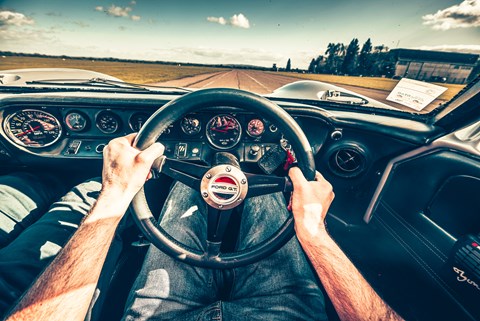
Not this car, though. One of only seven Mk3 road cars, more prominent headlights and a longer, luggage-friendly tail visually differentiate it. The damping is cushier and the gearlever has been moved from next to the right-hand door in racecars to this car’s centreline, making either left- or right-hand drive possible. In Ford’s care since new, this one’s value is estimated at £6m-£7m.
Where the other cars accommodate me, here I’m packaged to keep weight low and minimise drag. The doors open wide on conventional hinges but take most of the roof with them for easier access, then I straddle a chunky carpeted sill, before dropping down low on leather seats reclined like sun loungers.
I’m almost very comfortable – legs point straight ahead to perfectly laid-out pedals, the mid-sized three-spoke wheel is an easy reach – but the bottom of the dash squashes my knees. Even at a standstill, I do not feel fully in control.
Like the Mustang, the V8 displaces 4.7 litres, this time de-tuned a fraction from the racecars at 306bhp, and it chugs rambunctiously at idle, while through the glass behind me the pancake air filter greedily ingests air. At 998kg the GT40 is not particularly light given its mid-engined racer genes, but with space and liberal throttle it is just rampant, gobbling up straights and roaring with every downshift throttle-blip like a Tasmanian devil.

Thankfully the floor-hinged clutch is easier to manage than first impressions suggest, while a long-travel throttle helps me progressively mete out power and the gearshift (wooden ’knob, dogleg first) has a precise snick even if it does need a good solid push home.
Crucially, the balance and delicacy of the GT40’s handling is at odds with its muscle-car soundtrack – the loading and feel through the steering, the purity of the turn-in, how it puts its power down so capably. Fear never leaves me, but overall the GT40 encourages rather than cautions.
Ford hoped to sell many more examples of the road-legal GT40, but it cost as much as a house, petrol prices were climbing, the oil crisis was just a few years away…
The Fiesta proved a better fit for the times. Dubbed Project Bobcat and greenlit by the same Henry Ford who’d pushed through the GT40, the Fiesta was both Ford’s smallest car ever and its biggest investment to date, at over a million dollars.
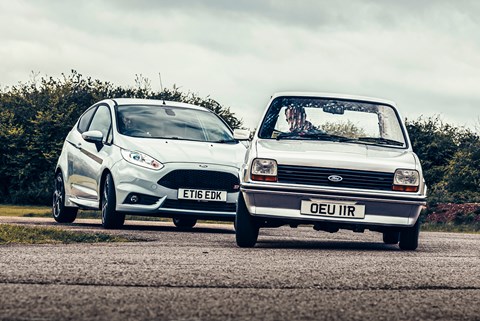
More sparse than a student bedsit inside, the Fiesta’s body is so narrow I can wind both windows simultaneously, as if I’m skipping, and everything is pared back to the minimum – two-spoke steering wheel, shelf instead of glovebox, more space ahead of the front seats than most EVs.
On the surface this is the unremarkable drive you’d forgive and expect. This car’s gearshift and brakes think it’s 4pm Friday, and the 957cc four is so coarse I’m tempted to do a quick oil-and-filter change.
Yet the ride is supple, and the steering accurately feeds back suspension loading and remaining grip. The Fiesta feels compact and extremely light on its feet. More than anything, the handling entertains, with some roll and bite at the front and a lively, adjustable feel if you lift the throttle mid-bend.
The building blocks for the hotter Supersport and XR2 models are most definitely in place, not to mention Ford’s increasingly front-wheel-drive future (the German-market Taunus actually pre-dates the Fiesta with front-wheel drive).
Ford was nowhere near done with rear-wheel drive yet, though, as the Capri attests. Launched in 1969 as a more compact, more fuel-efficient twist on the Mustang for Europeans but based on the Cortina, there are trans-Atlantic echoes in its proportions, not to mention copycat details on the Mk1 that included twin vents set ahead of the rear wheels and scalloped body sides.
American Philip T Clark designed the Mk1 – a logical choice given he’d worked on the Mustang. The Mk2 was Ford’s first hatchback; the Mk3 gently tickled that recipe for ’78.
Ford made 1,886,647 Capris, not only for Europe but V8-loving North America and Australia too, and this is the very last – a special-edition 2.8i officially called 280 and informally known as the Brooklands after its greenbottle-blue hue.
This is not a complicated car – strut suspension and a 2.8-litre Cologne V6 up front, live axle at the back. There are whiffs of JPS and other odours even the most floral Magic Tree can’t shift, but it’s the surprise of the day for me – a lovely GT feel, shot through with generous performance and exuberance.
Its leather Recaro seats have a sublimely comfortable squidge, while the three-spoke wheel turns with accuracy and fluid weighting and the chassis has a laconic sort of compliance – echoes of Mustang, yes, but more focus, more precision.
The 2.8 V6 has a harsher, less tuneful edge than an E30 BMW 325i straight-six, but there’s generous torque, a more rousing note when you push past 4000rpm and the sense that 160bhp is more than enough to exploit this extrovert chassis.
It certainly is in this case. This car’s tyres have good tread, but the rears are old enough to legally smoke – which is exactly what they do the second you point the nose at an apex, sitting there languidly if you keep the throttle pressed, the long wheelbase slowing all the weight transfer down. Lovely.
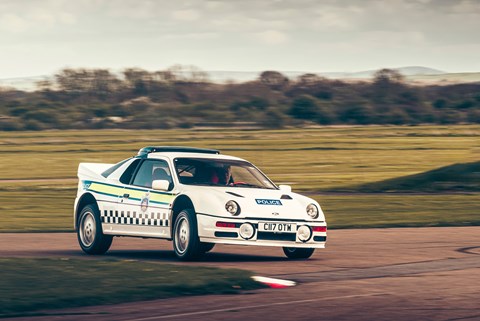
The RS200 from the same era is a very different kettle of fish, marking a return to GT40 levels of exoticism, this time for rallying after production-based Group 4 gave way to Group B and a requirement for only 200 cars.
Just like the MG Metro 6R4 and Peugeot 205 T16, the all-wheel-drive RS200 was far more radical than its production-based Audi Quattro rival in using a mid- rather than front-mounted engine, the twist being its fibreglass body resembled no other Ford. (This one’s police livery recreates a famous PR shot.)
Former BRM and Lotus F1 man Tony Southgate designed the chassis, its double wishbones joined by double coils and shocks, while the transmission is unusually mounted ahead of the driver, requiring drive to go first to the front wheels, then back again, much like a Nissan GT-R in reverse. You see it in a transmission tunnel as wide as a coffin, and you can certainly feel it in the low-speed clonks.
Despite the Group B fear factor, the RS200 is easy to drive quickly, with good stopping power, accurate steering and a surprisingly flat cornering stance given such lofty ground clearance. There’s also more neutral weight distribution than a GT40, so while the RS200 is nimble, it’s secure if you chuck it at the apex off-throttle, plus all-wheel drive calmly neutralises bursts of boost.
You are not serenaded. The 1.8-litre twin-cam turbo BDT might be related to the BDA in a Mk2 Escort RS1800, but rather than ravenous rasps it sounds as much a bag of nails as the Fiesta initially – the two both have Ford Kent genes, after all.
Boost is AWOL at moderate revs, but even at nearly 1200kg in road trim and with just the 237bhp, there’s real go on tap between 4000 and 6000rpm. The pedal action is nice, and the gearshift eases with speed in a way that helps you stay in that sweet spot.
Ford was late to the Group B party in 1984, and the RS200 helped trigger the category’s demise with a nasty crash at the 1986 Rally de Portugal. When Lancia suffered its second crew fatality on Corsica, Group B was gone. The more production-relevant Group A rose to prominence, and the Sierra RS Cosworth became Ford’s contender both for touring-car racing as planned, and rallying too. It was a Lotus Cortina for the ’80s.
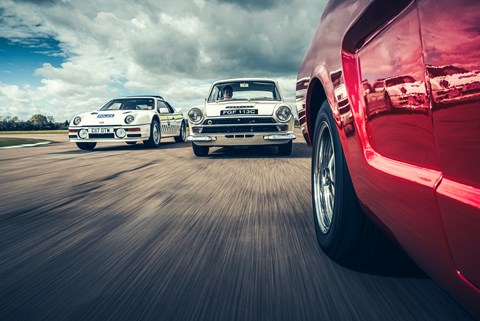
In fact, the Sierra was much like a later Mk5 Cortina underneath, Ford clothing familiar mechanical elements in significantly more aerodynamic bodywork to improve efficiency. ‘Jellymould!’shouted just about everyone.
The RS Cosworth was the two-fingered riposte to the initial bad press and gave Ford’s long-standing engine partner its first shout-out on the bodywork.
Like the rest of the mechanicals, the 2.0-litre Pinto iron block has Cortina ancestry, but Cosworth fitted a twin-cam 16-valve head and a Garrett T3 turbo to create the YB. The initial 201bhp stretched to 224bhp for RS500s made to exploit motorsport evolution regs, but these engines are good for more than 550bhp in race trim.
Other Cosworth upgrades included tougher transmission bits, uprated suspension and quicker steering. But it was the whale-tail rear wing that turned the ‘jellymould’ criticism on its head and made futuristic aerodynamics part of the whole point.
Of all the cars here, this is my fast-Ford trigger. Snuggle into another awesomely comfortable Recaro, twist the key and we’re away. The engine is unremarkable low down and doesn’t encourage higher revs. But keep it lit between 2500rpm and 4000rpm and there’s still the feeling that you’re grabbing the scenery and pulling it towards you. Boost just feels fast.
This driveline is far more fluid than you’d credit given the heavy-duty hardware, and the turn-in is crisp. The semi-trailing-arm independent rear suspension is much better tied down than the Capri – there’s both impressive body control and compliance to spare here – and it can still do flamboyant when the mood takes you.
The hot Sierra evolved from a three-door into the four-door Sapphire offered with optional all-wheel drive, and from there into the Escort Cosworth, where all-wheel drive was standard. The latter helped salvage the poorly received Mk5 and Mk6 Escorts, but it was a sign of just how dire things were that this ‘Escort’ was really a modified Sierra underneath, longitudinal engine and all.
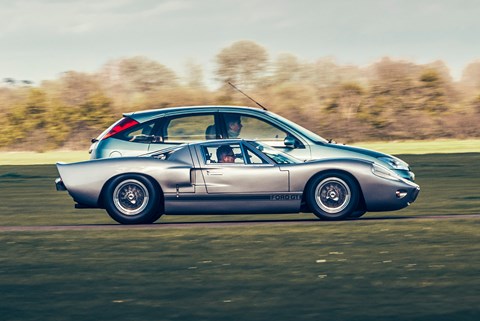
Enter the aptly named Focus for 1998, a clean-sheet replacement overseen by Ford R&D boss Richard Parry-Jones.
Time has dulled the impact of the New Edge design’s high-level tail lights, swept-back headlights and pronounced wheelarches, but in 1999 the radical design was a perfect visual tee-up for how crisply the Focus flowed down a road.
You do not have to be going quickly to appreciate this car’s talents – Parry-Jones called it the ‘50-metre test’ – thanks to feelsome steering, sorted pedal weights, a slick shift and a modestly powerful if peppy 1.6 engine. Wind it up a notch and there’s suspension travel for a smooth ride, bite at the front, and independent Control Blade rear suspension that’s easy to adjust on the throttle, if perhaps not as extrovert as legend suggests. This is the democratisation of fun handling and it’s still so good.
The second Fiesta ST continues that legacy, but I had low expectations ahead of the 2012 launch at Ford’s Lommel test ground; the first ST was okay, but Renault still ruled the market. However, this would turn out to be one of the best launches ever, partly because Track 7 twists like my dream B-road, and partly because the ST was so bolt-from-the-blue brilliant with its eager EcoBoost engine and playful handling. I left Lommel knowing we had a new class benchmark. The ST200 marked the Fiesta’s 40th anniversary in 2016.
The 1.6-litre four boosts the stock 180bhp to 197bhp, plus there are beefier anti-roll bars and a twist-beam rear some 27 per cent stiffer. It’s a little Scrappy Doo of a thing, amplifying the juice of the regular ST’s performance and extrovert chassis.
You can feel 20 per cent more torque tugging the steering, but the rowdiness brings its own kind of engagement, and because the rear end is even more playful than the original, you learn to use lift-off oversteer to get the car straight and stop the scrabble.
For any Luddite who still dismisses hot hatches as ‘wrong-wheel drive’, here’s your epiphany.
The One Ford strategy saw America take the Fiesta ST and us Brits get the sixth-generation Mustang in 2015, but who’d have guessed that a decade on the Fiesta would be dead and we could have as many Mustangs as we liked so long as they were V8s?
If jumping from the Fiesta is a jolt that emphasises the Mustang’s weight and size, it also underlines just how closely related the new Mustang’s DNA is to the original. The V8 has a characterful rumble, there’s a similarly lusty surge when you merely dip into the throttle that makes it feel so indulgently effortless and there’s response to make modern turbo stuff feel narcoleptic. Stretched to 7000rpm, it feels riotously powerful.
It also makes a decent fist of the twists and turns of the track at Bicester Heritage – a quicker steering rack perks up direction changes, the Brembos have both strong stopping power and good feel, and (though I’d prefer the interaction of a manual) this car’s 10-speed auto shifts promptly enough and doesn’t swap cogs too often.
Like the Fiesta, the Mustang also hangs at all sorts of angles, though this time it’s power-on rather than lift-off oversteer, and the resulting powerslides are more languid – it’s compulsory to drive with at least some lock on if you tap into this performance. It’s just what it does.
After the Fiesta, the Mustang does feel quite isolated, soft and heavy, and this car isn’t quite as hungry as the Dark Horse I drove in California – no wonder given the V8 loses 39bhp in deference to EU regulations and its exhaust is throttled by a gasoline particulate filter – but it’s still a lot of fun. What’s perhaps most striking with this new GT is how it channels the original spirit of Mustang while introducing a more nimble European flavour into the mix.

And how does the new Mustang stacks up against Ford European icons? In some ways it just doesn’t, which is precisely what makes it so appealing. The GT40 repackages the rambunctious V8 soundtrack, the Capri riffs on its styling, but Europe’s roads and people and fuel prices demanded a different breed of Ford in the mid-1960s.
Ever since, the Mustang has always gone its own way, creating and evolving a category that splits the difference between muscle car and sports coupe, in the process acquiring a uniquely enduring appeal. It’s perhaps why, of all the cars here, the Mustang is the Ford to outlive them all.